The AMD Threadripper 2990WX 32-Core and 2950X 16-Core Review
by Dr. Ian Cutress on August 13, 2018 9:00 AM ESTHEDT Benchmarks: Rendering Tests
Rendering is often a key target for processor workloads, lending itself to a professional environment. It comes in different formats as well, from 3D rendering through rasterization, such as games, or by ray tracing, and invokes the ability of the software to manage meshes, textures, collisions, aliasing, physics (in animations), and discarding unnecessary work. Most renderers offer CPU code paths, while a few use GPUs and select environments use FPGAs or dedicated ASICs. For big studios however, CPUs are still the hardware of choice.
Corona 1.3: Performance Render
An advanced performance based renderer for software such as 3ds Max and Cinema 4D, the Corona benchmark renders a generated scene as a standard under its 1.3 software version. Normally the GUI implementation of the benchmark shows the scene being built, and allows the user to upload the result as a ‘time to complete’.
We got in contact with the developer who gave us a command line version of the benchmark that does a direct output of results. Rather than reporting time, we report the average number of rays per second across six runs, as the performance scaling of a result per unit time is typically visually easier to understand.
The Corona benchmark website can be found at https://corona-renderer.com/benchmark
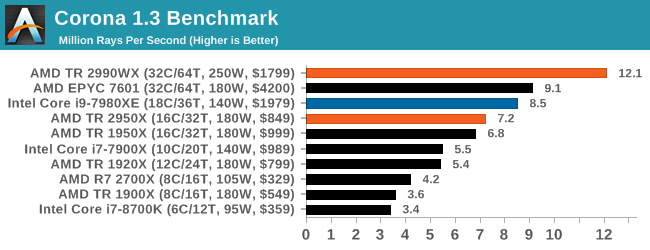
So this is where AMD broke our graphing engine. Because we report Corona in rays per second, having 12 million of them puts eight digits into our engine, which it then tries to interpret as a scientific number (1.2 x 10^7), which it can’t process in a graph. We had to convert this graph into millions of rays per second to get it to work.
The 2990WX hits out in front with 32 cores, with its higher frequency being the main reason it is so far ahead of the EPYC processor. The EPYC and Core i9 are close together, however the TR2950X at half the cost comes reasonably close.
Blender 2.79b: 3D Creation Suite
A high profile rendering tool, Blender is open-source allowing for massive amounts of configurability, and is used by a number of high-profile animation studios worldwide. The organization recently released a Blender benchmark package, a couple of weeks after we had narrowed our Blender test for our new suite, however their test can take over an hour. For our results, we run one of the sub-tests in that suite through the command line - a standard ‘bmw27’ scene in CPU only mode, and measure the time to complete the render.
Blender can be downloaded at https://www.blender.org/download/
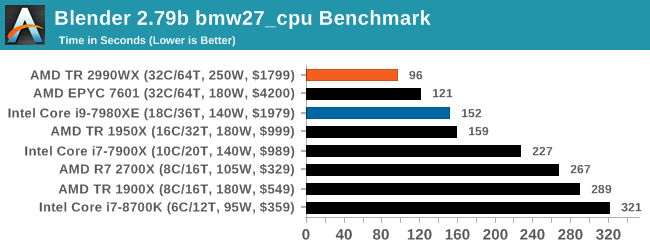
The additional cores on the 2990WX puts it out ahead of the EPYC and Core i9, with the 2990WX having an extra 58% throughput over the Core i9. That is very substantial indeed.
LuxMark v3.1: LuxRender via Different Code Paths
As stated at the top, there are many different ways to process rendering data: CPU, GPU, Accelerator, and others. On top of that, there are many frameworks and APIs in which to program, depending on how the software will be used. LuxMark, a benchmark developed using the LuxRender engine, offers several different scenes and APIs.

Taken from the Linux Version of LuxMark
In our test, we run the simple ‘Ball’ scene on both the C++ and OpenCL code paths, but in CPU mode. This scene starts with a rough render and slowly improves the quality over two minutes, giving a final result in what is essentially an average ‘kilorays per second’.
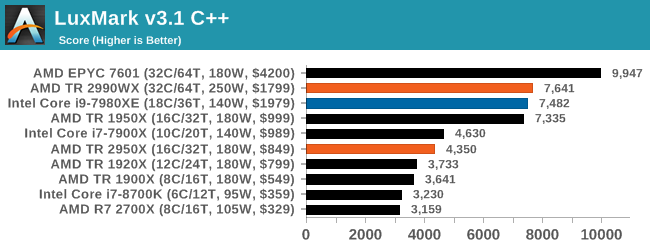
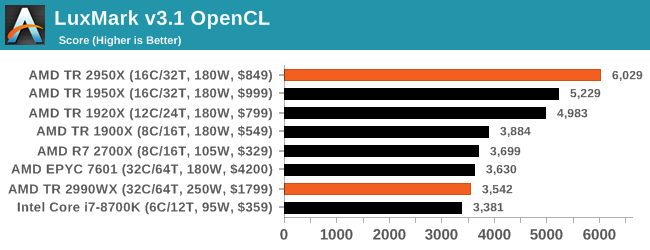
Intel’s Skylake-X processors seem to fail our OpenCL test for some reason, but in the C++ test the extra memory controllers on EPYC sets it ahead of both TR2 and Core i9. The 2990WX and Core i9 are almost equal here.
POV-Ray 3.7.1: Ray Tracing
The Persistence of Vision ray tracing engine is another well-known benchmarking tool, which was in a state of relative hibernation until AMD released its Zen processors, to which suddenly both Intel and AMD were submitting code to the main branch of the open source project. For our test, we use the built-in benchmark for all-cores, called from the command line.
POV-Ray can be downloaded from http://www.povray.org/
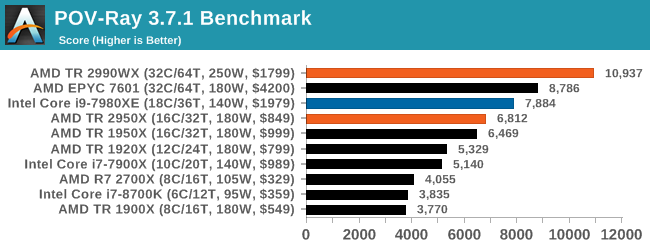
This test is another that loves the cores and frequency of the 2990WX, finishing the benchmark in almost 20 seconds. It might be time for a bigger built-in benchmark.


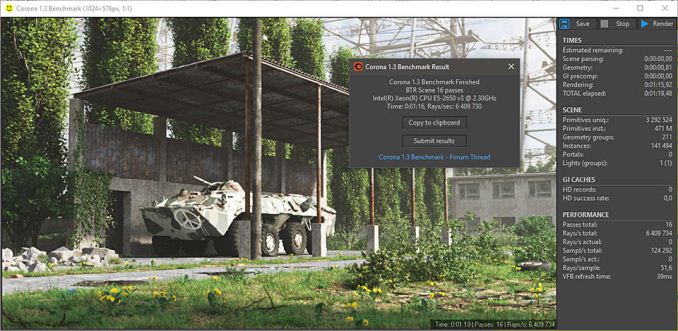








171 Comments
View All Comments
MrSpadge - Monday, August 13, 2018 - link
I don't think AVX512 is going to matter much anytime soon. However, The 8 memory channels of EPYC could matter a lot for HPC.ElFenix - Monday, August 13, 2018 - link
You guys need a 4k or maybe even 5k workload for transcoding - it's thread limited at 1080p so it becomes IPC and turbo limited. With x265 you can load up multiple 1080p handbrake instances on these high core count processors and they don't break a sweat.ElFenix - Monday, August 13, 2018 - link
That should be *1080p spawns limited numbers of threads*T1beriu - Monday, August 13, 2018 - link
>Europe is famed for its lack of air conditioning everywhereUK is a lot colder generally in the summer compared to the rest of Europe. I wouldn't generalize the lack of AC for the rest of Europe. AC is pretty common in my country.
jospoortvliet - Saturday, August 18, 2018 - link
Missing everywhere here in Germany... though after this insanely hot summer i bet that that will begin to change...powerincarnate - Monday, August 13, 2018 - link
I didn't see a lot of gaming benchmarks, which I guess I understand, since these are more workstation cpus. It would be good to have seen both though to get a better idea of the overall qualities of the cpu as a multipurpose care.It seems from tomshardware benches that 7980xe, especially when overclocked, is best overall. AMD 2990wx obviously winning on the pure multi-threaded workstation stuff as long as it is not memory intensive.
It seems like the 2950x from both of these sites, is really the processor to get from the threadripper lineup.
it seems when gaming is taken to account, the best of both worlds is the 7900x
And for gaming, and when you factor price as well, the 8700k, 8086, and slightly behind, the 2700x are the cards to get.
Overall.... I'm a little disappointed in this release. Was much more impressed with the 2700x. It's likely since we didn't really get a true change in the manufacturing process or design of the chip, that the limitations of the 2990wx will probably be ironed out with Zen2 (this is Zen+ after all).
bill.rookard - Monday, August 13, 2018 - link
Looking at it myself, yeah - these really aren't gaming CPUs by any stretch of the imagination, thus the lack of gaming benchmarks is perfectly understandable to me. As for the results of the benchmark results? I'm thinking the 2950x is the sweet spot. Lower power, lower latency, more power for the cores vs interconnects, and a much higher clockspeed makes it IMHO the better choice unless you have those fringe workloads which requires a bunch-o-cores.shendxx - Monday, August 13, 2018 - link
this guy come from Toms that said 7900x is best for both world, lol, when the graph from toms show clearly even on gaming, 2950x is equal on Minimum FPS with 8700k and only lose 3 to 10 FPS On Average,apoclypse - Monday, August 13, 2018 - link
I don't know. Gaming performance is the least thing I care about with this chip but that seems be all most tech press cares about, especially tech tubers. These chips are not for gaming. If anything these chips should be compared to Intel's Xeon line as it seems that is actually where AMD is aiming these at since they don't have a dedicated SKU for workstation chips like Intel. These are only marketed as HEDT chips because it gives AMD positive press, but if anything the ones who should be paying attention should be OEM high end workstation builders. In that regard Threadripper is more than compelling. It's higher clocked than Intel's Xeon chips, has more cores for less money, and still has all the pro level features that is needed for workstation level work.I think AMD should lean into that a bit more in their marketing but that stuff isn't sexy and it doesn't grab attention like marketing it towards rich and stupid "gamers", and the technorati who eat that stuff up.
This is a workstation chip period, and should be treated, tested and benchmarked as such, imo.
Icehawk - Monday, August 13, 2018 - link
If only the tier 1 vendors would offer TR workstations... I really wanted to purchase a few for work to use as VM hosts but my only real option is Xeon currently. The 32 core monster would likely make for a great VM host for mid-weight usage.